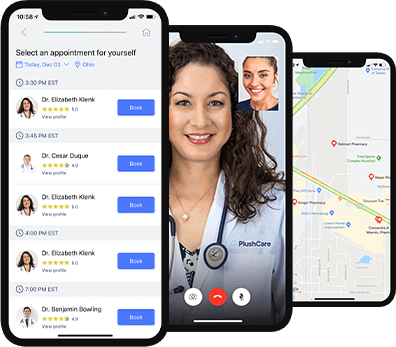You can get a sore throat for a wide variety of reasons, but the two most common tend to be strep throat and the common cold. Although the two illnesses exhibit similar symptoms, they are widely different in how they affect the body. Read ahead to learn the differences between strep and a cold, including symptoms, causes, prevention, and treatment.
What is Strep Throat?
Strep throat is a bacterial infection that most characteristically causes inflammation and swelling in your tonsils and in the mucus membrane along the back of your throat. Strep throat is most common among kids and teens age five to 15. An estimated 15 to 40 percent of sore throats in this age group are a result of strep throat.
Strep throat is generally less common in adults, but it is still possible. About 5 to 10 percent of sore throats in adults are caused by strep throat.

1
Book on our free mobile app or website.
Our doctors operate in all 50 states and same day appointments are available every 15 minutes.
2
See a doctor, get treatment and a prescription at your local pharmacy.
3
Use your health insurance just like you normally would to see your doctor.
What Causes Strep Throat?
There are two types or species of Streptococcus bacteria. Group A Streptococcus (GAS), also known as Streptococcus pyogenes, is the more common of the two species and is the main cause of strep throat, though it is also responsible for scarlet fever, toxic shock syndrome, and certain skin infections. Group B Streptococcus is rarer and more associated with blood infections, pneumonia, meningitis, and other serious conditions.
How do bacteria end up in your system? The Streptococcus bacteria is highly contagious. It’s most often spread when you come into contact with someone who is carrying the bacteria or when you touch a phone, doorknob, or other object that has been touched by someone with strep throat.
The Streptococcus bacteria also tends to gather in your nose, mouth, and the back of your throat. Coughing and sneezing allows the bacteria to travel into the air via water droplets. If you were to breathe in these particles or come into contact with them, you may end up with strep throat.
The Common Symptoms of Strep Throat
Symptoms for strep throat differ from person to person based on age and personal health and fitness. The symptoms usually become apparent within five days after the bacteria first enters your system.
The main symptom is throat pain that comes on suddenly and quickly. The tonsils and the back of the throat will look red and swollen and sometimes have deposits of white, a condition known as tonsillar exudate.
Other symptoms you may experience with strep throat include:
A fever, often measuring 101 degrees Fahrenheit or higher
Tender, swollen lymph nodes along the sides of your neck
Headaches
Coughing
General malaise
Nausea and vomiting
Red spots on the roof of your mouth
A loss of appetite
Infants with strep throat may be irritable or fussy and feed less. They may also have nasal discharge and a low-grade fever. Along with some of the above symptoms, older children may complain of abdominal pain and eat less food.
Diagnosing Strep Throat
Because the symptoms of strep throat overlap with many other types of infections, your doctor may need to perform tests to determine if you are actually suffering from a strep infection.
The main test is known as the rapid antigen test. Using a swab sample from your throat, your physician can determine if you have the strep bacteria in your throat. This test takes just a few minutes. If it shows negative results but your doctor still suspects that you have strep throat, they may perform a throat culture.
Treating Strep Throat
While many cases of strep throat can clear up on their own with bed rest, you can be prescribed medication to cure your strep throat, manage its symptoms, or prevent any complications that may arise from it.
If you do see a medical professional for strep throat, you will likely be prescribed an oral antibiotic, usually penicillin or amoxicillin. If you take antibiotics within two days of strep throat’s initial onset, you can significantly reduce the duration of the infection. Antibiotics taken early will also reduce the severity of the infection, the risk of more serious complications, and the chances of spreading the infection to others.
Using antibiotics for strep throat, you should feel better in one to two days. Most courses of antibiotics will take about a week and a half. Make sure you take the full course that your doctor prescribes. Ending your course early may result in a relapse or lead to more serious complications, including kidney inflammation and rheumatic fever.
In terms of relieving symptoms, you may be prescribed to take an over-the-counter pain reliever to reduce your fever and any pain you may be feeling in your throat. This includes acetaminophen (Tylenol) or ibuprofen (Motrin).
What is the Common Cold?
The common cold is a viral infection of your nose and upper respiratory tract. While it can leave you feeling weak and physically struggling, the common cold is generally not a serious or life-threatening issue. While children under the age of six are the most susceptible to the common cold, adults can expect fairly frequent colds. The average adult will have the cold two or three times each year.
What Causes the Common Cold?
Unlike strep throat, which is caused by bacteria, the cold can be caused by one of several viruses. In fact, over 200 types of viruses can cause the cold. The most common is known as rhinovirus and accounts for up to 40 percent of colds. Next is coronavirus, which is responsible for about 20 percent of colds. Parainfluenza and respiratory syncytial viruses are responsible for about 10 percent of colds.
Much like with Streptococcus, common cold viruses are highly contagious. You can catch it from coming into contact with someone who has the cold or from touching any surface (a doorknob, keyboard, or phone) that may have the cold virus on it. Once it’s on your hands, it can enter your system when you touch your face, where it can attach to the lining in your nose or throat.
Alternately, you can catch the cold by being around someone who sneezes or coughs, causing the virus to enter the air via water droplets.
Contrary to popular belief, the cold isn’t actually caused by cold weather. However, cold air does dry the mucus linings in your nose and throat, which makes it easier for bacteria and viruses to stay and grow in your body. Cold weather also forces more people to congregate indoors, meaning more recycled air and germs in close quarters.
Common Symptoms of the Cold
The most common symptoms of the cold comprise a persistent cough with a sore throat, runny nose, and plenty of sneezing. Other symptoms of the common cold include:
Congestion
A low-grade fever
General malaise
Slight aches throughout your body
A mild headache
Muscle aches, higher fevers, and other severe symptoms may be more indicative of a flu or sinus infection.
Diagnosing the Cold
Diagnosis often comes down to identifying your symptoms and performing a physical examination. If the doctor suspects that you actually have a bacterial infection or other condition, they may order an X-ray or other test to determine what may be causing your symptoms.
Treatments for the Cold
There’s no cure for the cold, and because it is caused by a virus, antibiotics have no effect. Thankfully, most instances of the cold will go away on their own. Most cases shouldn’t last more than seven to ten days, but if your symptoms linger, you should absolutely call your doctor or consult a health care professional.
Any treatments for the cold tend to focus on mitigating your symptoms and enhancing your overall comfort. Common forms of treatment for the common cold include:
Pain relievers: Over-the-counter pain relievers like acetaminophen can take care of headaches and sore throats while reducing fevers at the same time.
Cough syrups: Cough syrups can help to suppress coughing and soothe sore throats.
Decongestant nasal sprays: These nasal sprays can help to alleviate congestion, but avoid using nasal sprays for longer than a few days. Constantly using nasal sprays may actually irritate the mucus lining in your nose, which may lead to discomfort and a greater spread of the virus.
Contrary to what many people believe, there’s no evidence to suggest that taking vitamin C will treat or prevent the cold. However, some studies suggest that zinc may be helpful to your immune system.

1
Book on our free mobile app or website.
Our doctors operate in all 50 states and same day appointments are available every 15 minutes.
2
See a doctor, get treatment and a prescription at your local pharmacy.
3
Use your health insurance just like you normally would to see your doctor.
Home Remedies for Strep Throat and the Cold
While strep throat and the cold may differ in their actual structure, they overlap when it comes to self-care and home remedies. The best remedy for both the cold and strep throat is plenty of bed rest and good meals to give your body the energy to fight the infections.
Stay home if you can to go easy on your body and prevent the spread of infection. Other things you can do at home to ease your symptoms include:
Drinking plenty of fluids: Make sure you drink water to stay hydrated. Water also keeps your throat moist, making it easier to swallow. Herbal tea, soup, and other warm liquids can help to loosen mucus in your throat and ease congestion.
Eat comforting food: Puree foods in the blender for easy swallowing. Cold foods, like ice cream, popsicles, and sherbet, can soothe your throat and numb any soreness. Avoid acidic and spicy foods, which may only irritate your throat and your digestive system. Aim for foods that are soothing and easy to swallow and digest. This includes foods like:
Oatmeal
Soup and broth
Applesauce
Mashed potatoes
Yogurt
Soft fruits
Eggs
Use a humidifier: Dry air means a dry throat, which doesn’t feel good and only contributes to growing bacteria and viruses. Humidifiers can add moisture to the air, easing your physical discomfort and keeping your nasal passage and throat moist.
Preventing the Spread of Strep Throat and Cold
Most of the prevention of these two diseases simply comes down to washing your hands properly with soap and warm water. If you can’t wash your hands, use a hand sanitizer.
If you’re sick, try to stay at home. Being contagious means you can easily spread your strep throat or cold to coworkers, peers, friends, and family around you. If you do have be in public, wear a face mask. Sneeze or cough into a tissue or into your elbow, not your hands. Avoid sharing any personal items, like drinks or utensils.
If you experience any serious complications or discomfort or your symptoms remain for longer than a couple weeks, you may require prescription medication. Consult your physician or visit an urgent care center.



